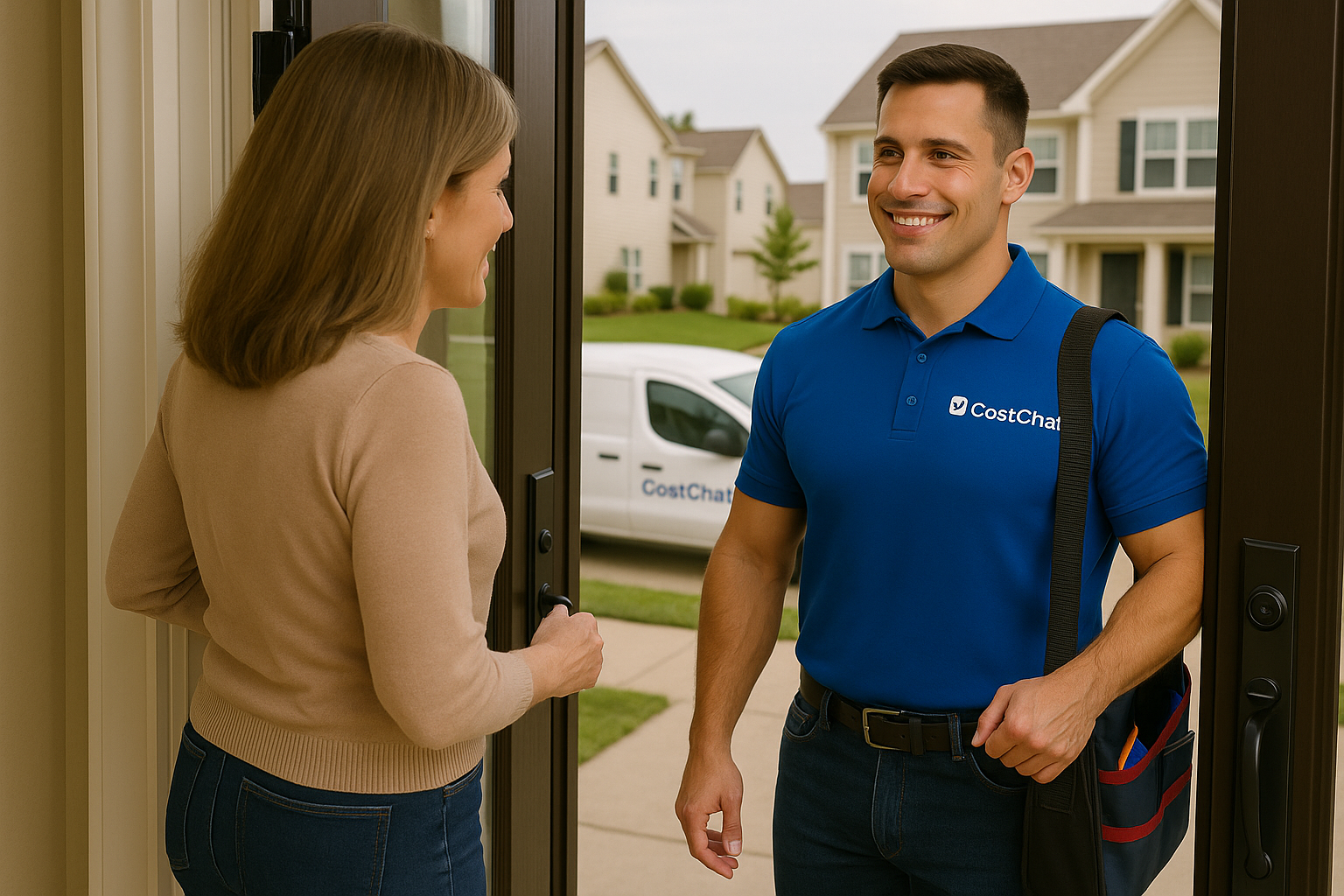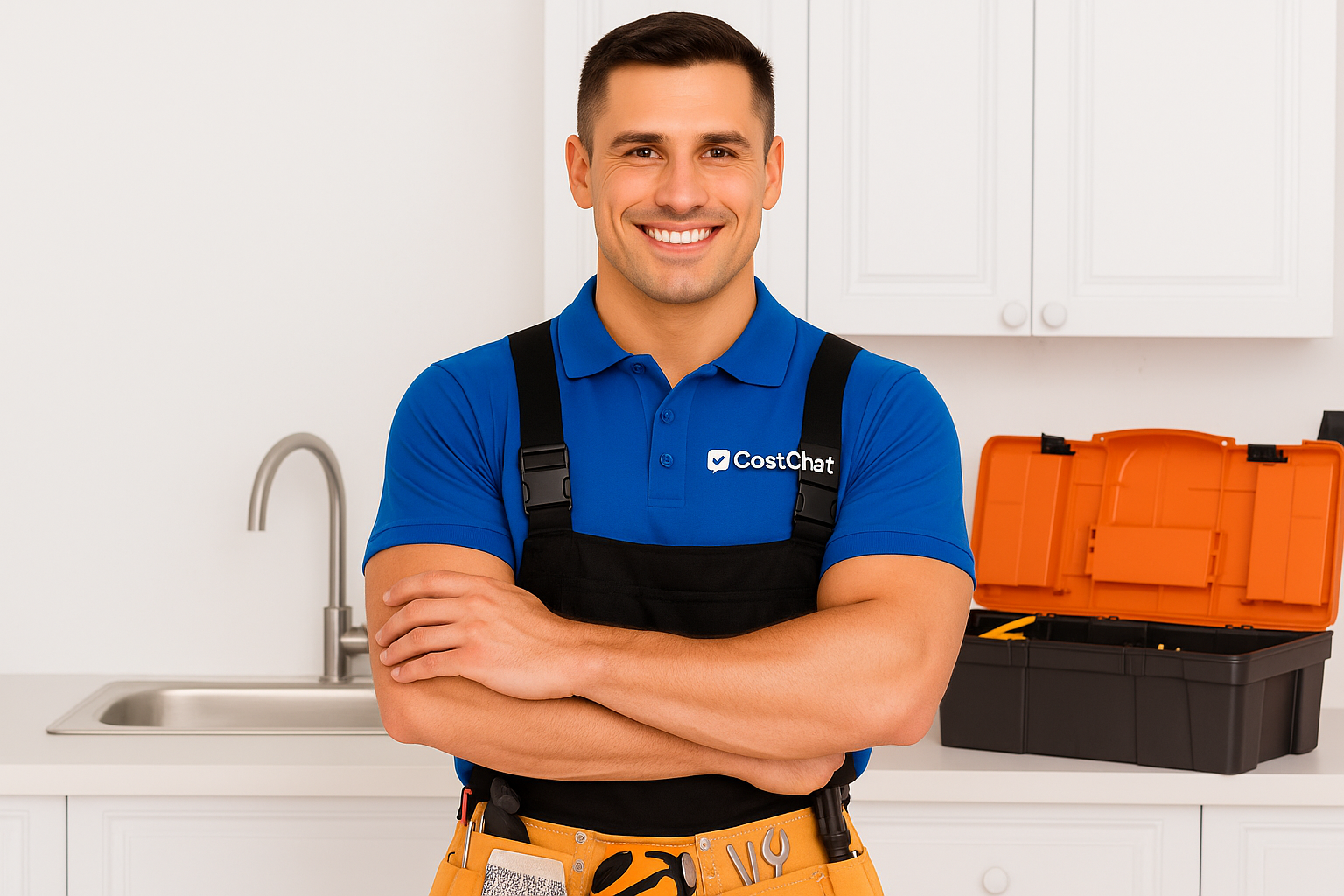
Find Top Local Water Line Repair Providers in Sioux Falls, SD – Book Today
How to Hire Top Rated Water Line Repair Pros in Sioux Falls, SD
Get a Free Online Estimate
Share your project details and receive a free online estimate from top-rated local pros. Not sure what it should cost? Check our Cost Guide.
Get EstimateCompare Local Quotes
View multiple free online quotes side by side. Use our Price Guide to understand labor rates, materials, and service fees before you hire.
Compare NowBook Best Top Rated Pros
Choose a licensed pro with confidence. Lock in your date after reviewing your free estimate and browsing our expert Cost Guide for peace of mind.
Book NowDid You Know?
74% ⚠️
of homeowners face surprise costs and delays — mostly from hiring unvetted pros. Don’t risk it. Hire trusted experts today.
Hire Top Rated & Verified ProsWork With Verified & Trusted Pros 🛡️
Save time, avoid costly mistakes, and experience reliable, top-quality service for every home project. Book now for priority scheduling and peace of mind.
Hire a Top Rated ProGet Instant Online Estimate of Water Line Repair in
🔎 CostChat Online Cost Estimator
Describe your project and location to get an instant estimate.
Your Essential Guide to Water Line Repair in Sioux Falls, SD
As a homeowner in Sioux Falls, SD, you understand the importance of a reliable and efficient home infrastructure. Keeping your home comfortable and your utility bills manageable is a top priority, and that includes ensuring your water lines are in optimal condition. When water line issues arise, they can be stressful and disruptive. This guide is crafted specifically for Sioux Falls residents to provide comprehensive, local insights into water line repair, helping you navigate potential problems, understand solutions, and make informed decisions.
Table of Contents
- Sioux Falls, SD's Unique Water Line Repair Landscape: Why Local Expertise Matters
- Neighborhood Hotspots: Micro-Local Water Line Repair Risks & Solutions
- Common Problems & Triggers for a Professional Water Line Repair Call
- Navigating Sioux Falls, SD Regulations: Permits, Code & Professional Licensing
- Maximize Your Savings: Sioux Falls, SD Water Line Repair Rebates & Incentives
- Choosing Your Sioux Falls, SD Water Line Repair Component: Models, Sizing & Smart Features
- The Cost of Water Line Repair in Sioux Falls, SD
- Hiring Sioux Falls, SD's Top-Rated Water Line Repair Professionals: Your Action Plan
- FAQs About Water Line Repair in Sioux Falls, SD
Sioux Falls, SD's Unique Water Line Repair Landscape: Why Local Expertise Matters
The Age & Character of Sioux Falls, SD Homes: A Water Line Repair-Related Time Capsule
Sioux Falls, SD, with an estimated 2025 population of around 215,000 across 78 square miles, boasts a diverse housing stock. The city's steady growth, averaging about 2% annually, means many homes have seen decades of use. The majority of single-family homes were built from the mid-20th century onwards, featuring popular styles like ranch, split-level, and contemporary suburban designs. Prominent neighborhoods such as McKennan, Highland, and Prairie Hills showcase this mix, with many properties dating from the mid-1900s to the early 2000s.
Older homes, particularly those constructed in the mid-20th century, often contain original plumbing materials like galvanized steel pipes and cast iron drain lines. These materials are susceptible to internal corrosion and mineral buildup over time, which can significantly reduce water flow and lead to leaks. Galvanized pipes are especially prone to rust, while older cast iron drain lines can develop cracks or blockages. For homes with slab foundations, which are common in Sioux Falls, plumbing leaks within the slab can be particularly challenging to detect and expensive to repair.
As Sioux Falls continues to grow, home remodeling and additions are frequent occurrences. It's crucial that when these updates happen, the underlying plumbing systems are assessed and upgraded if necessary to support new fixtures or increased demand, ensuring long-term reliability.
Sioux Falls, SD's Environmental & Utility Factors & Climate Impact on Your Water Line Repair
The City of Sioux Falls Water Division manages the city's water supply, which is sourced from multiple locations including the Big Sioux River, groundwater from the Big Sioux and Middle Skunk Creek Aquifers, and treated water from the Lewis and Clark Regional Water System. Sioux Falls water is characterized as hard water, meaning it contains a higher concentration of minerals. Over time, this can lead to mineral scale buildup within water lines, potentially reducing flow and stressing pipes.
Sioux Falls experiences a continental climate marked by significant temperature fluctuations. Winter brings freeze-thaw cycles, creating a substantial risk of frozen and burst pipes, especially if plumbing in exterior walls, crawl spaces, or attics is not adequately insulated. Spring rainfall can lead to soil saturation, causing ground shifts that may stress underground piping and joints. Conversely, summer drought conditions can also contribute to soil contraction and movement. Moderate flood risks exist near the Big Sioux River, prompting caution for homeowners in those areas and the potential need for sump pumps and backflow prevention.
 Request a Quote
Request a Quote
Neighborhood Hotspots: Micro-Local Water Line Repair Risks & Solutions
Sioux Falls' diverse neighborhoods present unique challenges for water line integrity. Understanding these local nuances is key to proactive maintenance and timely repairs.
McKennan Park Area
Risks: Homes in the McKennan Park area, often built in the mid-20th century, may still have older galvanized steel water lines that are prone to corrosion and reduced water flow. The mature landscaping can also mean tree roots seeking water might interfere with underground pipes.
Solutions: Consider a water line inspection to assess the condition of existing pipes. If corrosion is significant, repiping with modern materials like PEX or copper could be a cost-effective long-term solution. Root intrusion can sometimes be addressed with pipe lining or careful excavation and rerouting.
South Sioux Falls
Risks: This area features a mix of newer and older construction. Newer homes might have plumbing installed within concrete slabs, which can be vulnerable to leaks if not properly installed or if soil settlement occurs. Older sections may share the same legacy pipe issues as other established neighborhoods.
Solutions: For slab leaks, early detection is crucial. Utilizing advanced leak detection equipment can minimize damage. For older homes, proactive replacement of aging lines is recommended.
Prairie Hills & East Sioux Falls
Risks: These areas often have a higher concentration of homes built in the late 20th and early 21st centuries. While materials may be more modern, improper installation during rapid development phases or specific soil conditions could still lead to issues like joint leaks or pipe damage from ground movement.
Solutions: Regular checks for water pressure drops or unexplained moisture can help identify emerging issues. Ensuring any work done adheres strictly to current plumbing codes is vital.
Common Problems & Triggers for a Professional Water Line Repair Call
Recognizing the signs of a failing water line can save you from significant damage and expense. These indicators are often exacerbated by Sioux Falls' specific environmental factors.
Warning Signs of Water Line Issues
- Unexplained drop in water pressure: This can indicate a leak or a significant blockage within the main water line.
- Cloudy or discolored water: Rust or sediment buildup in older pipes can cause discoloration, a common issue with galvanized steel.
- Foul-smelling or bad-tasting water: This could point to pipe corrosion or contamination, especially with older materials or potential leaks in the ground.
- Hissing or running water sounds: Even when no fixtures are in use, these sounds often signal an active leak.
- Spongy or damp spots on walls or floors, or visible water damage: This is a clear indicator of a leak, potentially within walls or under foundations.
- Increased water bills: A sudden, unexplained spike in your water bill is a strong indicator of an unseen leak.
- Lush green patches in your yard: A leak underground can saturate the soil, leading to unusually vibrant plant growth.
The lifespan of water line components can vary greatly. While modern materials might last 50-100 years, older galvanized steel pipes often begin to fail significantly between 20-40 years of age due to corrosion. Cast iron drains can last 50-75 years but are prone to cracking.
It’s important to know what to do if you suspect a major leak. For immediate guidance, consult our What to Do in a Plumbing Emergency guide.
 Request a Quote
Request a Quote
Identifying Potential Leaks
Pay close attention to the subtle signs. If you notice any of the symptoms listed above, it's time to consider a professional assessment. Early detection, as highlighted in our Warning Signs of Plumbing Issues guide, is crucial for minimizing damage and cost.
Navigating Sioux Falls, SD Regulations: Permits, Code & Professional Licensing
Ensuring your water line repair or replacement project complies with local regulations is essential for safety, quality, and avoiding future legal issues.
Permitting Process and Governing Codes
In Sioux Falls, major plumbing work, including water line repairs or replacements, requires a permit. The Sioux Falls Development Services Center is the authority responsible for issuing these permits. You can find more information on their website, typically accessible through the City of Sioux Falls Development Services Center portal.
Sioux Falls adheres to the International Plumbing Code (IPC), with amendments specific to South Dakota state regulations and local conditions. These codes ensure that all installations meet stringent safety and performance standards.
Required Inspections
Typically, water line installations and major repairs require inspections at various stages:
- Rough-in Inspection: Before any pipes are covered (e.g., behind walls or under concrete).
- Pressure Test Inspection: To ensure the system holds pressure without leaks.
- Final Inspection: After all work is completed and fixtures are connected, confirming compliance with all codes.
DIY vs. Professional Installation
While some minor plumbing tasks might be suitable for DIY enthusiasts, water line repair is complex and often involves working with municipal water systems and under pressure. Incorrect installation can lead to leaks, water damage, and violations of building codes. We strongly recommend using licensed professionals for all water line work. For more on this, explore our When to Consider DIY guide.
Contractor Licensing and Verification
Plumbers in South Dakota must be licensed. You can verify a contractor's license status through the South Dakota Department of Labor and Regulation. It is critical to hire licensed and insured professionals. Always ask for proof of both and confirm they are valid.
To verify licenses: Visit the South Dakota Department of Labor and Regulation Licensing Portal.
Maximize Your Savings: Sioux Falls, SD Water Line Repair Rebates & Incentives
Investing in water line upgrades can be more affordable than you think, thanks to available rebates and incentives designed to encourage water efficiency and system improvements.
Local and Regional Rebate Opportunities
Homeowners in Sioux Falls may be eligible for rebates on water-saving fixtures and appliances, which can indirectly benefit your water line system by reducing overall demand. Keep an eye on programs offered by the City of Sioux Falls and regional utility providers. While specific amounts can change, these programs often target high-efficiency toilets, showerheads, and leak detection systems.
Strategic Savings Tips
Bonus Tip: Timing your water line upgrades with other planned home renovations can sometimes lead to cost savings by consolidating labor and permits. Always check for current rebate programs before starting any project.
For more ways to manage costs, consult our Saving Tips for Home Services guide.
 Request a Quote
Request a Quote
Choosing Your Sioux Falls, SD Water Line Repair Component: Models, Sizing & Smart Features
Selecting the right materials and approach for your water line repair is crucial for durability and performance in Sioux Falls' climate and water conditions.
Understanding Water Line Materials
The primary options for water line replacement are:
- Copper: Durable and corrosion-resistant, but can be more expensive and susceptible to freezing in extreme cold.
- PEX (Cross-linked Polyethylene): Flexible, less prone to freezing than copper, and generally more affordable. It's resistant to corrosion from hard water.
- HDPE (High-Density Polyethylene): Often used for underground service lines, very durable and resistant to ground movement.
Sizing and Application Considerations for Sioux Falls
Proper sizing depends on your home's water usage demands. A professional will assess the number of bathrooms, fixtures, and occupants to determine the appropriate pipe diameter. Given Sioux Falls' hard water, materials that are inherently resistant to mineral buildup, like PEX or copper, are excellent choices. Ensuring adequate insulation for any exposed or exterior lines is vital due to the freeze-thaw cycles.
Key Sioux Falls Water Line Considerations
- Hard Water Resistance: Choose materials less affected by mineral scale.
- Freeze Protection: Ensure proper installation and insulation for pipes in vulnerable locations.
- Soil Conditions: Select durable materials for underground lines that can withstand potential ground shifts.
- Code Compliance: Always ensure materials and installation methods meet current IPC standards.
The Cost of Water Line Repair in Sioux Falls, SD
The cost of water line repair in Sioux Falls, SD can vary significantly based on the scope of the work, the materials used, and the complexity of the repair. For a main water line replacement, homeowners can expect costs to range from $2,000 to $7,000 or more, depending on factors like trenching requirements, excavation depth, and the length of pipe needed.
Factors influencing cost include:
- Type of Repair: A small leak repair might cost a few hundred dollars, while a full line replacement is considerably more.
- Materials: Copper is generally more expensive than PEX.
- Excavation: If extensive digging or concrete cutting (for slab foundations) is required, labor and restoration costs increase.
- Depth and Accessibility: Deeper or harder-to-reach pipes will incur higher labor costs.
- Permits: Permit fees are typically included in the professional's quote.
- Neighborhood Specifics: While not a primary cost driver, some areas might have unique access challenges.
Average hourly rates for plumbers in Sioux Falls can range from $75 to $150 per hour. It is always recommended to obtain multiple detailed quotes from qualified professionals to compare pricing and scope of work.
 Request a Quote
Request a Quote
Hiring Sioux Falls, SD's Top-Rated Water Line Repair Professional: Your Action Plan
Choosing the right professional for your water line repair is paramount. A skilled and reputable plumber can ensure the job is done correctly, efficiently, and to code.
Tips for Selecting a Professional
- Verify Licensing and Insurance: Always ensure the plumber is licensed by the state and carries adequate liability insurance.
- Check Local Reviews: Look for reviews on reputable platforms and ask neighbors for recommendations.
- Get Multiple Quotes: Obtain at least three detailed written estimates that break down costs for labor, materials, and permits.
- Ask Hyper-Local Questions:
- "What materials do you recommend for Sioux Falls' hard water conditions?"
- "Have you worked with underground pipes in the [mention your neighborhood] area before, and are there any specific concerns?"
- "How do you handle freeze protection for water lines in our climate?"
- "What is your process for obtaining necessary permits from the City of Sioux Falls?"
- Review the Contract: Ensure a detailed written contract outlines the scope of work, materials, timeline, warranty, and payment schedule.
Avoiding common pitfalls is key. Review our Mistakes to Avoid When Hiring a Contractor guide for valuable insights.
Neighborhoods We Serve in Sioux Falls, SD
️ Top Neighborhoods:
- Downtown
- Hospital & University District
- South Sioux Falls
- Southwest Sioux Falls
- East Sioux Falls
- All Saints
- Cathedral
- Galway Park
- Garfield
- McKennan Park
- Oak View
- Pepper Ridge
- Pettigrew Heights
- Terrace Park
- Tuthill Park
- Whittier
- Canton
Top ZIP Codes Covered:
- 57101
- 57103
- 57104
- 57105
- 57106
- 57107
- 57108
- 57109
- 57110
- 57117
Wherever you’re located in Sioux Falls, SD, our team of trusted local pros is nearby—ready to deliver fast, reliable, and top-rated service. Whether you’re in the heart of downtown or a quiet suburb, we’ve got you covered.
FAQs About Water Line Repair in Sioux Falls, SD
What are the most common signs of a water line leak in Sioux Falls, SD?
Common signs include a sudden drop in water pressure, discolored or foul-smelling water, unexplained damp spots on walls or floors, hissing sounds from pipes, and a noticeable increase in your water bill. These can be indicators of leaks or corrosion, issues common in older Sioux Falls homes.
How does Sioux Falls' hard water affect my water lines, and what can be done?
Sioux Falls' hard water contains minerals that can cause scale buildup inside pipes over time. This can restrict water flow and potentially damage pipes. Using PEX or copper for replacements is recommended, as they are more resistant to corrosion and buildup. Regular maintenance and flushing can also help mitigate these effects.
Do I need a permit for water line repair in Sioux Falls, SD?
Yes, typically major water line repairs or replacements require a permit from the City of Sioux Falls Development Services Center. Licensed professionals will handle the permit application process as part of the service.
How concerned should I be about frozen pipes in Sioux Falls, SD?
Given Sioux Falls' continental climate with significant freeze-thaw cycles, frozen pipes are a real concern. Ensure any water lines running through unheated spaces like crawl spaces or garages are properly insulated. If you suspect a frozen pipe, turn off the main water supply and call a professional immediately.
Ready for Reliable Water Lines?
Don't let water line issues disrupt your comfort or home's integrity. Understanding the local challenges and knowing what to look for empowers you to make the best decisions for your Sioux Falls home.
Request a Quote